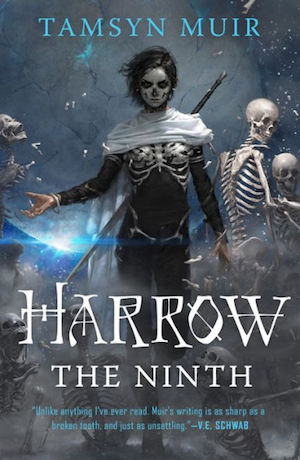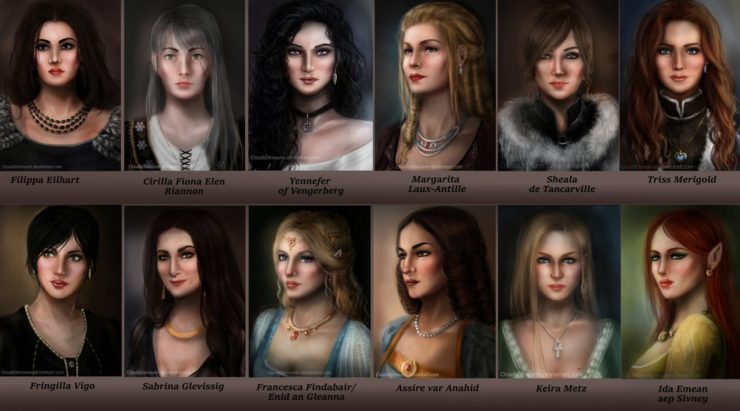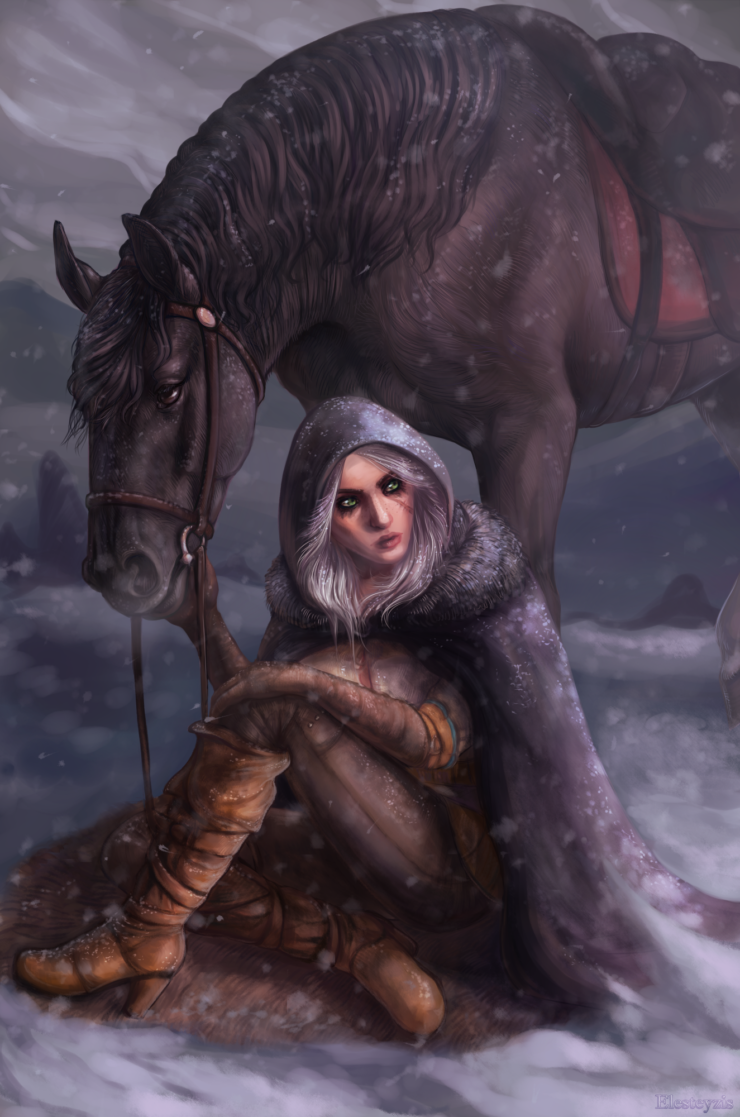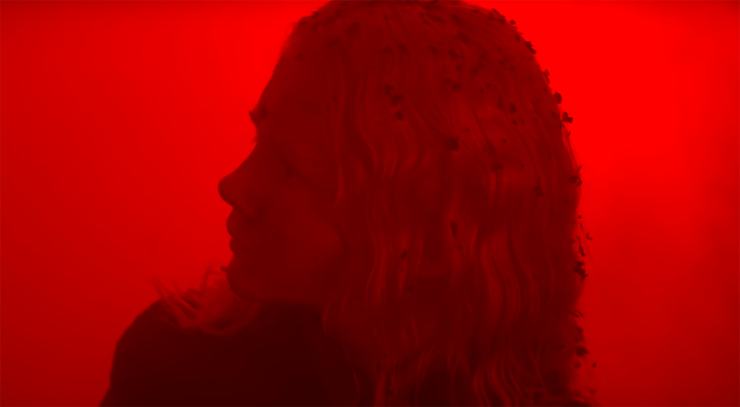The world of The Witcher is a bleak place. Fearsome leshens lurk in the shadows of the forest. Deserted castles are home to vampires, strigas, and other terrifying creatures. Geralt of Rivia, the white-haired monster-slayer who treads the Path in search of work, encounters in his travels war-torn wastelands, plague-infested villages, and endless hordes of raping, pillaging brigands. Luckily for everyone, Geralt is more than capable of wielding a sword amidst all of these dangers. And yet this world is also home to hazards and concerns that aren’t always explored within the action and drama of conventional epic fantasy fiction.
In particular, women and women’s bodies play a hugely important role in Andrzej Sapkowski’s books. The Polish author’s fictional universe depicts the agonising pain of miscarriage, as well as characters dealing with sterility and arranged marriage. In these pages, readers are just as likely to encounter the sting of the abortionist’s needle as the mortal strike of a basilisk. The female body is depicted in surprising and thoughtful ways, even amidst the spattered blood and guts of war. Furthermore, the role of women in politics adds another fascinating layer to the world that Geralt must navigate. Sapkowski doesn’t pander to women, nor does he patronise them. His portrayal of relationships between women encompasses well-meaning sisterhood as well as spiteful in-fighting. At the heart of all this turmoil is Ciri, Geralt’s ward and the Child of the Elder Blood, whose transition from girl to woman takes place under the most extreme circumstances imaginable. Geralt is the series’ main protagonist—the eponymous ‘witcher’ of the best-selling books and games—but he is surrounded on all sides by a cast of complex, fearless women whose own struggles with their bodies and their status in society are brought to life in surprisingly vivid detail.
[Spoiler warning: This article discusses various character arcs and events that take place in Sapkowski’s books, on which the upcoming Netflix series is based. If you don’t want to know anything about the source material before watching the show, you may want to revisit the article after the series airs on December 20th.]
For one thing, the topic of menstruation is addressed at several key moments in the books. Periods are a natural part of life on the Continent, even for the prophesied Child of the Elder Blood, and Ciri’s witcher training is abruptly interrupted by Triss Merigold once the young girl starts her first period. The witchers of Kaer Morhen are all men and have never trained a girl before, so they don’t fully understand the symptoms of PMS, while Ciri is too embarrassed to tell them what she’s going through. At first, this situation provides some light amusement: Who would have imagined the superhuman Geralt of Rivia having to confront his adopted daughter’s changing body like any other awkward dad? However, not only does this development add a dose of reality to Ciri’s witcher training, Sapkowski also uses it to remind us that in a world where everyone from emperors to mages are obsessed with Cirilla’s bloodline, the girl is now capable of having a baby—a prospect that introduces new complications and higher stakes into the overall equation. Furthermore, Ciri survives a testing ordeal in the desert thanks to Yennefer’s travel package, filled with “things a lady always ought to have.” Among other items, it contains a tampon which Ciri unrolls and uses as a headband. Soon after this, a climactic scene in the books shows Ciri realising the true extent of her magical abilities—something which terrifies her rather than empowers her. She renounces her magic and loses consciousness, but not before she vaguely realises that “blood is trickling down her thigh.” We realise that the so-called Lion Cub of Cintra is no longer really a “cub,” but rather a lost and confused teenager.
Ciri’s periods also remind us about the distinct lack of contraception in the Medieval fantasy land of the Witcher books. It’s easy to forget this when most of the sex scenes we encounter involve Geralt, who is sterile due to the mutagens he ingested in order to become a witcher. But Ciri’s sexual awakening is a little more cautious out of obvious necessity, and in one scene we actually witness her counting the days since her last period before having sex: “just to be sure, she reckoned the days from her last bleeding. Yennefer had taught her that.” However, Ciri is right to be careful about pregnancy. Sapkowski doesn’t shy away from depicting the risks that pregnancy poses in a world where even surviving labour under the best of circumstances can be a challenge for a woman.
Buy the Book


Harrow the Ninth
One fascinating side story from the books involves Milva, a talented archer who joins Geralt and some male companions in their search for Ciri. As the group rides on an ill-fated journey south, past military forts and refugee camps, Milva realises that she is pregnant quite literally in the middle of a war zone. At first everyone (including Milva herself) believes that she is vomiting either because of a hangover or food poisoning. But eventually Milva realises she is pregnant and needs a concoction to abort the baby. Why does Sapkowski choose to include this added problem among all of the other immediate trials and tribulations the group faces on their journey? And it is a problem. As Regis states, if Milva keeps the baby she will need “wholesome, regular meals, no stress. Sufficient sleep. And soon the end of horseback riding.” If she doesn’t choose to keep the baby, the effects of the concoction will still prevent her from travelling for weeks. Milva’s male companions have a tense discussion about “what to do.” Unlike the others, Cahir comes from the Nilfgaardian Empire and thus is an outsider of sorts. He says that in his country, “the woman decides. No one has the right to influence her decision.” Dandelion immediately backs him up: “It’s obvious that only the woman can make a decision like that.” Geralt and Regis remain more reserved, and in the end Milva decides to keep the baby after a deeply emotional conversation with the witcher.
Nevertheless, the huntress’ pregnancy is doomed. The group are soon caught up in yet another random conflict, and Milva takes an arrow wound which causes her to miscarry. Nowadays we’re used to encountering fearless warrior women in many different genres of literature, film, and television; women who fight like men and die in battle alongside their fellow warriors. Milva is a far better archer than most of the men or women she encounters, and she saves the lives of her male companions several times over. She is also a woman in a fantasy world where contraception does not exist—her sexual relationships occasionally have consequences for her body. Through her story, Sapkowski manages to depict the emotional turmoil of unwanted pregnancy and miscarriage even when arrows are flying overhead and soldiers are hacking each other to pieces, treating these matters with the weight and gravity they deserve.
Female sterility is also a recurring theme in the books, and nowhere do the deeply personal, potentially tragic aspects of this condition become more apparent than in Yennefer’s story. Ironically—cruelly even—Yennefer was born on Belleteyn, an Elven fertility festival. It’s already clear from the recent Netflix trailer that the series will explore her tragic backstory in much more detail than the games—suffice to say there’s a lot to unpack, as Yennefer’s bravery, strength and power as an accomplished and influential sorceress are thrown into stark contrast with the torment of her younger years. In the books, she carries a certain sadness that Geralt can’t fix or remedy, in spite of his best efforts. For all sorcerers and sorceresses in the world of The Witcher series, the price of great magical power is sterility. Born on a fertility festival, and gifted with magical abilities to grant other women fertility, Yen desperately seeks a solution to her own inability to have a child, stating: “If I want something, I don’t dream of it—I act. And I always get what I want.” Unfortunately, despite going to extreme lengths to become pregnant, Yennefer never bears a child of her own. Some may interpret this as a commentary on how traditionally high-achieving career women have had to “sacrifice” family life, and there are certainly some parallels, here. Fortunately for Yennefer, her destiny is entwined with that of Ciri’s, and fans of both the books and games will be aware of the strong mother-daughter bond that exists between them—a bond which finally gives Yennefer the child she always wanted.

Although they cannot restore their own fertility, sorceresses do have plenty of other impressive powers. They control chaos, create objects from thin air, heal wounds, change the weather… At the same time, many of them are also shallow, catty, and cruel. Yennefer’s relationship with Geralt is a constant source of amusement to the other enchantresses, who joke about Yen’s “old age” and sneer at her willingness to “lose her head” over the Witcher. Most sorceresses are also prone to judging the appearances of their fellow magicians—Yennefer included. Geralt listens idly as she and Philippa Eilhart marvel at their colleague Sabrina Glevissig’s revealing choice of clothing, with Yennefer labelling Sabrina a “revolting cow.” The creation of the Lodge of Sorceresses is a significant political moment in the books, but it is peppered with examples of the women involved snidely insulting each other’s appearances. To underscore the pettiness of these exchanges, Sapkowski gives us a fascinating insight into the future hundreds of years after this event, showing how the Lodge of Sorceresses has been esteemed throughout history. Unsurprisingly, their image has been carefully shaped through the use of books and art. They are spoken of in revered tones and praised for their canny political ingenuity, which contrasts humorously with the nasty bickering that reflects the reality of the Lodge’s storied creation.
The Lodge itself is a fascinating reversal of familiar gender stereotypes. After the mixed-gender Chapter has been dramatically dissolved, Philippa proposes a new type of magical governance: “This organisation will consist exclusively of women.” Although this idea is initially met with raised eyebrows by the other sorceresses, it’s also presented as a natural step forward. After all, “men are psychologically unstable, too prone to emotions.” A women-only form of governance makes sense, since nobody can deny the “natural and undeniable domination of our sex.” Sapkowski turns gender stereotypes completely on their head: In this world, men are the unstable rulers who allow their actions to be swayed by emotion—a charge often levelled at female politicians even to this day. The women of this world view men as inferior because they are unable to make rational decisions, and so the Lodge of Sorceresses comes into being.
However, far from being some kind of post #MeToo utopian sisterhood, the Lodge simply takes up the same kind of cynical political manoeuvring that we had come to expect from more traditional, male-dominated regimes. Catty remarks are the least of anyone’s concerns as it becomes clear that this new secret organisation is really a case of “meet the new boss, same as the old boss.” Yennefer discovers to her horror that the sorceresses are not above manipulating their fellow women “in the interests of the Lodge,” and Ciri and her womb are at the heart of their machinations. The sorceresses want to take control of Ciri’s powers for themselves; arranged marriage and the careful mapping of her potential offspring are just a means to an end. Although their plans for Ciri are certainly far less violent and disturbing than those of the male sorcerer Vilgefortz, the same desire to manipulate and control Ciri’s bloodline is uncomfortably similar.
Beyond the Lodge and its aims, sorceresses also have other, less obvious but equally as important matters that must be dealt with in order to maintain their power and influence. In the political sphere of the Continent, appearances matter. Sorceresses have to play the game in spite of their great power, and so they devote a lot of time to jewellery, clothing, cosmetics, and the rest. Yennefer is constantly brushing her hair, and Geralt notices that she wears ultra-rare basilisk heels the first time they meet. The sorceresses don expensive jewels and revealing clothing to enhance their near-perfect figures. Of course, magic helps in this regard too, and the Netflix trailer already hints at the dramatic lengths that sorceresses go to in order to change their bodies and appearances. At first glance, the reader might think that a lot of this concentrated effort seems superficial or self-indulgent, but in fact it’s the only way to ensure that kings and emperors will bother to listen to them—“our status in society demands it.” Their superhuman beauty also helps to distinguish them from the common folk (or “rabble,” as Philippa lovingly refers to the general populace).
Interestingly, the sorceresses from Nilfgaard are dowdy and unkempt. Keira Metz is horrified at Assire var Anahid’s broken fingernails, not to mention her drab clothing. Assire fits the role we might think of as the tortured magical genius who doesn’t care about trivial things like makeup and perfume. However, although Assire herself is initially shocked at the extravagant, highly sexualised appearances of the sorceresses from the North, eventually she realises that she wants to play their game. Assire explains her decision to wear makeup by arguing that “it’s high time we challenged the superstition that dressing up is proof of an enchantress’s flightiness and the superficiality of her mind.” Women in power can look after their appearance without being airheads, in other words. In his books, Sapkowski plays upon two all-too-familiar types of criticism often lobbed at real-world female politicians and leaders, reflecting the paradox back at us through the text—we expect a woman to ‘look good’ for us because of her place in society…but look too good and she risks being thought of as shallow and superficial. Despite the Medieval-style fantasy setting, it’s hard not to be reminded of the British media’s fascination with Theresa May’s shoes, or more recently the uproar in the US over Alexandria Ocasio-Cortez’ visit to a hair salon.
However, the women we encounter in the Witcher books are not limited to powerful sorceresses. At various points we meet queens, dryads, peasants, female assassins, poets, priestesses…and then, once again, there is Ciri. Ciri is a unique character within the world of the Witcher. In the books, and to a lesser extent in the games, we see her grow from girl to woman in a land where almost everybody wants a piece of her. Ciri’s ancestry means that she is a carrier of the Elder Blood and possesses formidable magical powers. Surely that makes her a sorceress too, then? In fact, Ciri’s identity is completely confused and morphs from one book to another as she takes up with different factions. Cirilla, Princess of Cintra, the Lion Cub, Child of the Elder Blood, Zireael, Falka—she is referred to by many different names, and as she grows older her identity begins to fracture.
Ciri’s entire story is entwined with Fate. But the way that Ciri interprets her own destiny changes as she is forced to survive on a Continent obsessed with taking control of her. At first, we believe her stay at Kaer Morhen will transform Ciri into a witcher—the first female witcher ever known. After all, she is Geralt’s Child of Surprise, and even her own nanny tells her that one day the White Wolf will take her away to train her as a witcher. She does undergo the training; however, for various reasons she does not undergo the same trials that male witchers were subject to, including the Trial of the Grasses (which would have seen her ingest powerful mutagens). She is not a witcher in the traditional sense, then. Yennefer begins Ciri’s magical training and the pair form a strong mother-daughter bond as Ciri’s abilities grow more and more powerful. However, after escaping the infamous coup on the Isle of Thanedd and becoming separated from her guardians, Geralt and Yennefer, Ciri spends her formative years with a band of outlaws known as “the Rats,” before eventually passing time in the world of the elves of Aen Elle.

All of these experiences leave Ciri confused about who she really is. She is constantly running from danger while trying to figure out her own identity. At various points she declares that she is a witcher: “I’m a witcher. I kill monsters.” However, her time with Yennefer also leaves a serious impression on her, and in one dramatic scene from the books Ciri explains her actions by stating, “I’m an enchantress. I seize life by the scruff of the neck.” With the Rats she adopts a new name and identity, but doesn’t seem convinced by it: “I am Falka. But I wasn’t always. Not always.” Finally, due to her elven bloodline, Ciri is greeted by the elves as one of them, although she is seen as tainted by her human ancestry. This confusion points toward us toward potential parallels between Ciri and another famous fantasy character, in particular—Arya Stark, of the Song of Ice and Fire novels. Like Arya, Ciri can never truly let go of the past. Despite the multitude of names and aliases Ciri inhabits, her desire to reunite with Geralt and Yennefer never dies. She will get her wish, in time—but not before she undergoes a period of serious trauma and transformation.
Indeed, another identity that Ciri inhabits is that of Death itself. Encountering the Wild Hunt in Time of Contempt, ghostly apparitions chase the frightened ashen-haired girl through the trees, insisting that while they are corpses, “you are death.” At another point, a beggar stares Ciri in the eyes and simply states: “you yourself are death.” Ciri’s story is entwined with death as well as fate, and she develops a complicated relationship with it. Her parents and grandmother die, she witnesses the slaughter of Cintra as a young girl, and later sees her friends murdered and beheaded in front of her eyes. Throughout this ever-worsening series of traumatic experiences, violence becomes a necessity for survival…and eventually even a thrill. As a member of the Rats, we see her stab someone to death in a marketplace for making a lewd comment in her direction. Mistle notes that “Falka” desires killing more than sex—her bloodlust grows day by day. Ciri has become a lost and confused soul who goes from vomiting at the sight of a dead body to relishing violence, a terrifying young woman “dealing out death.” This character arc is arguably a strain of teenage rebellion set amid the most extreme circumstances imaginable. Ciri is relentlessly pursued by sadistic mages, powerful emperors, scheming sorceresses, and menacing elves…the list goes on. She ends up temporarily evading all of them and instead spends her days as a rebel, stealing, fighting, and doing drugs.
However, by the time she is finally reunited with Geralt and Yennefer, Ciri is tired of death, her supposed alter ego. Although she will kill to survive, the Lady of the Lake (as she is known in at least one world, in the fifth novel) ultimately rejects violence as a way of life and doesn’t like to be reminded of her past actions. Unlike her fictional counterpart Arya, who fully embraces her talents as an assassin, Ciri realises that the lives she takes come at the cost of her own humanity, so it is better to avoid killing unless absolutely necessary. (Sound familiar? Geralt’s training at Kaer Morhen clearly doesn’t go to waste.) Eventually her story ends close to where it began, with Ciri embracing the life of a witcher (albeit one with the ability to travel through different worlds and times!).
Throughout the Witcher saga, Geralt’s story is clearly intertwined with the lives of multiple fascinating, complex, and powerful women. In light of this, it’s a shame that the book covers used on the Gollancz editions of the English translations reduce the female characters to buxom, scantily clad versions of themselves. The designs don’t quite do justice to the strong, multifaceted women of the Continent that we know and love. Although outward appearances are certainly important within the social structures of Sapkowski’s world, to the uninitiated potential reader, Season of Storms looks more like straightforward erotica than a rich and engaging fantasy masterpiece. Happily, it’s safe to say we can expect a bit more depth from the upcoming Netflix series, which will be focusing on three main stories rather than one. Ciri and Yennefer are consistently represented in promotional material, particularly through the symbols of the swallow and obsidian star. Although there will likely be some sex scenes on the cards (just like in the books), we’ll also hopefully go much deeper into the complexity of Sapkowksi’s female characters. The trailer suggests the series will be exploring Yennefer’s backstory in far more detail than even the books did, adding an extra layer of fragility to her confident exterior. As if book and game fans weren’t excited enough, Netflix has already commissioned a second season, meaning that we should get to see how showrunner Lauren Hissrich and company begin tackling Ciri’s dramatic character arc. One thing is for certain: December is about to bring some truly formidable women to our screens.
Rachel lives in Edinburgh and writes about pop culture, philosophy and plenty of things in-between. She has previously written articles for History Today and Electric Literature. Loves reading, gaming and anything to do with the 16th century. You can find her author bio here.










